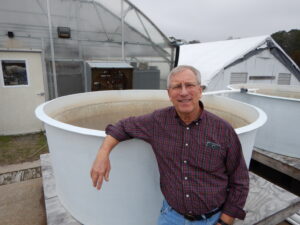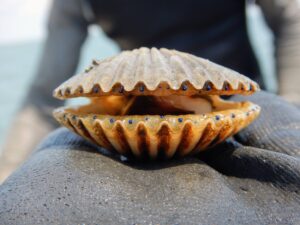by Kristen Minogue
Two decades ago, it was almost impossible to find eelgrass in Virginia’s South Bay—or many of the other small bays behind the barrier islands along the state’s eastern shore. After a barrage of disease followed by a powerful hurricane wiped them out by 1933, many thought the eelgrasses would never return. With the eelgrass went the brant goose, a popular waterfowl for sport hunting, and a lucrative bay scallop industry that had brought in millions of dollars per year.
“Because the bay scallop relies on the eelgrass as it’s growing up, it just completely disappeared and never came back,” said Jonathan Lefcheck, a marine biologist with the Smithsonian Environmental Research Center.
Today, a 20-year restoration has transformed South Bay and its neighboring bays into an oasis. But for the scientists leading the effort, restoring the eelgrass wasn’t enough. They wanted to find out if all the benefits eelgrasses provide would return as well. A new Science Advances report finally gave them their answer.
The Bays That Were Left Behind

Robert “JJ” Orth stands beside a VIMS tank for holding seagrass flowers, which the team used to generate seeds for the eelgrass restoration. (Credit: Paul Richardson)
The restoration began with Lefcheck’s mentor, Robert “JJ” Orth of the Virginia Institute of Marine Science. Orth had already worked on seagrass restorations in the main stem of Chesapeake Bay. However, a past attempt to bring eelgrass back to Virginia’s coastal bays in the 1980s had failed. This led some experts to think those bays had somehow become inhospitable to the plants—even though the bays’ cooler, clearer waters should have been perfect eelgrass habitat.
That changed in 1997, when Orth’s team heard a rumor that someone had discovered a natural patch of eelgrass in South Bay. Upon closer investigation, they discovered several small eelgrass patches growing on the bay floor.
“When we saw that, the light went on,” Orth recalled. “Maybe there’s something about these bays—like, no seeds.”
“Openings to these coastal bays were so narrow that these seeds from populations elsewhere that had recovered since the ‘30s just weren’t able to get there,” Lefcheck said. While places in other parts of the mid-Atlantic saw their seagrasses returning, these bays had been left behind.
So began the effort to reseed South Bay. Over the next 20 years, teams of researchers and citizen volunteers would scatter nearly 75 million seeds at over 500 different sites. Gradually the project expanded to include nearby Cobb, Spider Crab and Hog Island Bays. All four bays sit in the Virginia Coast Reserve of The Nature Conservancy, a UNESCO Biosphere Reserve, another advantage that made these bays ripe for restoration.
Orth’s initial guess proved right: These bays were hospitable to eelgrass. Once the seeds took root, eelgrass growth mushroomed beyond anyone’s expectations. Today, the restored eelgrass meadows cover over 9,000 acres. That’s roughly 17 times more area than the spots where Orth and his team originally planted seeds.
“It just exploded,” Lefcheck said.
But the lingering question remained: Did the burgeoning seagrass beds make any difference for the rest of the environment?
Restoration’s Ripple Effects

Jonathan Lefcheck (left) and intern Claire Murphy examine a striped burrfish cloaked in eelgrass on a 2019 survey. (Photo courtesy of Jonathan Lefcheck)
Seagrasses are the underdogs of aquatic habitats. They don’t get nearly as much attention as the more photogenic coral reefs. However, they provide many of the same benefits, including coastal protection and shelter for undersea animals—and some benefits that corals don’t do so well, like carbon storage. Seagrasses also grow all over the planet, from the edge of South America to the Arctic Circle.
“They’re everywhere,” Lefcheck said. “And we are just beginning to discover exactly how important they are.”
Lefcheck joined Orth’s team in 2015, as a postdoctoral researcher with the Virginia Institute of Marine Science. By that time, the eelgrass restoration had been booming for more than a decade. Lefcheck’s job was to find out if some of the lost environmental benefits had returned too.
The water had become even clearer than before. This wasn’t surprising, as seagrasses have a knack for slowing down waves and making particles fall to the seafloor. The seagrasses were also soaking up carbon and nitrogen, according to the new report. That effect grew even better with age. “Mature” seagrass beds (10 or more years old) stored 30% more carbon and over twice as much nitrogen as 1- to 5-year old seagrass beds, according to Karen McGlathery, a University of Virginia professor who leads research on the Virginia Coast Reserve Long-Term Ecological Research project.
Biodiversity came flooding back as well. Only a few years after the restoration began, invertebrate animals were just as abundant in the restored bays as in places where eelgrass had never disappeared, like Maryland’s Chincoteague Bay. Fishes were also taking advantage of the new habitat. Perch fish dominated, followed closely by the pinfish, a subtropical fish rarely seen this far north before the restoration. Orth has also seen birds swooping in to feed, like the brant goose that disappeared from these bays almost 100 years ago.

Bay scallops, a lucrative fishery that disappeared with the eelgrass, are now starting to return. (Photo: JJ Orth)
There are signs that bay scallops are slowly returning to Cobb and South Bays, thanks to a parallel seeding effort begun in 2008. Even so, they’re a far cry from the multimillion-dollar industry of a century ago.
“I think we’ve got a long way to go with bay scallops,” Orth said. However, he hopes aquaculture could help the scallops take off more.
Most restoration projects don’t last as long as this one. They also usually don’t look for the extra services restored species give on the side. But for Orth, seeing so many things come back after being gone for over half a century made the effort worthwhile.
“It can happen pretty quickly,” he said. “In 20 years, we saw a rapid recovery of all these basic services that people thought would have never returned.”
Read the full report in Science Advances: https://advances.sciencemag.org/content/6/41/eabc6434
DOI: 10.1126/sciadv.abc6434

